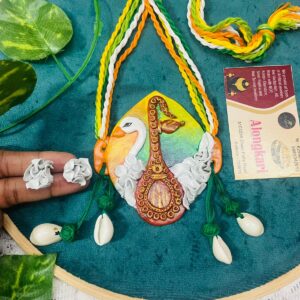The Art of Crafting Clay Jewelry
One of the primary techniques used in clay jewelry making is hand-building. This method allows artisans to mold and shape the clay with their hands, giving them complete control over the design and ensuring that each piece is unique. Molding is another popular technique, where clay is pressed into pre-made molds to create consistent shapes and patterns. Once the basic shape is formed, the piece is often refined with tools to add intricate details and textures.
Glazing is a crucial step in the process, as it not only adds a protective layer to the jewelry but also enhances its visual appeal with a glossy finish. The choice of glaze can significantly impact the final look of the piece, with options ranging from matte to high-gloss finishes, as well as a variety of colors and effects.
The tools and materials required for crafting clay jewelry are varied and specialized. Basic tools include sculpting instruments, rolling pins, and cutting blades, while more advanced techniques may require kilns for firing the clay. The time and effort invested by artisans are immense, as each piece undergoes multiple stages of shaping, detailing, and finishing to ensure it meets the highest standards of quality and beauty.
In essence, the art of crafting handmade clay necklaces and earrings is a blend of tradition, skill, and creativity. Each piece is a testament to the artisan’s dedication and craftsmanship, making handmade clay jewelry not just an accessory, but a timeless fashion statement.
Styling and Caring for Your Clay Necklace and Earrings
Handmade clay necklaces and earrings are not only fashion-forward but also versatile accessories that can enhance a variety of outfits. For casual settings, consider pairing a colorful clay necklace with a simple white blouse and jeans. The vibrant hues can add a pop of color, making your outfit stand out effortlessly. For a more formal occasion, opt for a more sophisticated clay necklace and earring set. A minimalist design in neutral tones can complement a classic little black dress or a tailored suit, adding a touch of elegance without overpowering your ensemble.
Festive occasions call for a bit more flair. Brightly colored or intricately designed clay jewelry can be the perfect match for traditional attire such as sarees, lehengas, or even modern fusion wear. The handmade aspect of clay jewelry often brings a unique, artisanal touch that can make your outfit even more special.
Maintaining the pristine condition of your clay jewelry requires some care. To clean your clay necklaces and earrings, use a soft, damp cloth to gently wipe away any dirt or residue. Avoid using harsh chemicals or abrasive materials, as they can damage the delicate surface. When it comes to storage, keep your clay jewelry in a cool, dry place, preferably in individual pouches or a jewelry box with compartments to prevent them from rubbing against other pieces and getting scratched.
Handle your clay jewelry with care to avoid any accidental damage. Clay is a sturdy material, but it can be sensitive to water and extreme temperatures. Avoid wearing your clay accessories while swimming or during rigorous activities that may expose them to excessive moisture or heat. With proper care, your handmade clay necklaces and earrings can last for many years, continuing to be a cherished part of your accessory collection.
Understanding the longevity and care of clay jewelry allows you to fully appreciate its value and the craftsmanship involved. By taking these steps, you can ensure that your handmade pieces remain as captivating as the day you first wore them.





Reviews
There are no reviews yet.